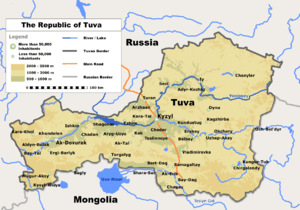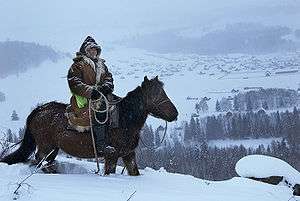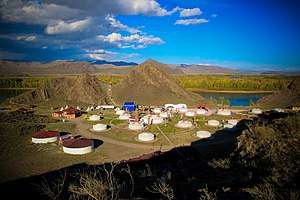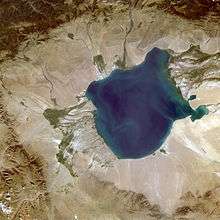Tyva
Tyva or Tuva (Russian and Tyvan: Тыва́ tyh-VAH) is a region in Eastern Siberia, bordering Altai to the west, Khakassia to the northwest, Krasnoyarsk (region) to the north, Irkutsk Oblast to the northeast, Buryatia to the east, and Mongolia to the south.

Other destinations

- Arzhaan Shivilig — a "medicinal" spring near many cultural monuments
- 🌍 Azas Nature Reserve
- 🌍 Uvs Nuur Basin — in 2003, the UNESCO listed the Uvs Lake Basin as a natural World Heritage Site. It was nominated as "one of the largest intact watersheds in Central Asia where 40,000 archeological sites can be found from historically famous nomadic tribes such as the Scythians, the Turks and the Huns." This transboundary patrimony is one of the largest sites inscribed in the World Heritage List to date.
- 🌍 Lake Tere-Khol
Understand
Tyva is on the border with Mongolia and shares much in common with the adjacent Mongolian regions. Tyvans comprise the largest ethnic group (over 60%) in the region and Tibetan Buddhism, mixed with indigenous Shamanism, is the predominant religion.
Perhaps Tyva's greatest offering for the visitor is its musical treasure: Khoomei, also known as throat-singing or overtone-singing, is a method in which the singer simultaneously produces a low drone and a series of higher melodies over the drone note. There are throat-singing traditions elsewhere — notably among the Inuit (Eskimo) in Canada and Alaska — but the Tyvan music is utterly unique and a performance is a powerful experience. There is a fine film Genghis Blues about a blind American blues singer's trip to Tyva.
Tyva is also of interest for its diverse and impressive wild landscapes. Tyva's topography spans desert, grassy steppe, lakes, and snow-covered mountains, many of which are dotted with cultural monuments of the Tyvan and Scythian herdsman who have roamed across the region for millennia.
Tyvans suffered greatly under Soviet repression of their culture and religion, particularly at the incidents of 1929, in which shamans and Buddhist monks were ruthlessly arrested and killed in a large-scale act of cultural vandalism against the Tyvan minority. As a result, foreign tourists are likely to be greeted with an even warmer welcome than in most of Siberia, as they are seen as part of a new future for Tyva that values the region's traditions. Many of the Tyvans were forced by the Soviet government to abandon their nomadic lifestyle and to work on collective farms, but to this day Tyvan culture remains essentially rural and, to a lesser degree, nomadic. Accordingly, to experience the "real" Tyva, you will need to get out into the countryside, among the sacred peaks of the Western Sayan.
Talk
Tyvan is, along with Russian, the official language of the region and is widely and usually spoken by ethnic Tyvans. Russian, however, is understood by nearly everyone in Kyzyl and usually in towns, somewhat less in the villages in more remote areas of Tyva, where few Russians live.
Get in
Tyva is largely well cut off from the rest of Russia by its mountainous borders and as a result, there is no rail service to Kyzyl. The new railway is now under construction, which is scheduled to finish by 2020. The best option is to take the train from Moscow to Abakan (76 hours), with one-way fares varying from approximately RUB4000 to RUB9500. The price changes according to peak tourist seasons in Russia: by far the cheapest day to travel is 1 January, while July is the most expensive.
It is possible to take a bus from Abakan in neighbouring Khakassia, but is not advisable. The route meanders through the gorgeous Sayan mountain landscapes of the Ergaki region, which would be foolish to miss. The train from Moscow arrives in Abakan at 6AM, and apart from the bus, there will be plenty of taxi drivers offering to take you to Kyzyl (approximately 420 km (260 mi) from Abakan) for RUB1000-1500. There is a possibility that you may have to register at the Russian-Tyvan border — just hand over your passport to the police officer, there is no fee for the service.
Kyzyl Airport is small and offers flights to and from the Siberian center of Krasnoyarsk as well as Raduzhny, Khantia-Mansia because of the number of people who work in the oil industry there. The direct flights from Moscow to Kyzyl have been resumed as of Fall 2007, the flight goes twice a week via Ufa, Bashkiria's capital, departing from Moscow on Sunday and Wednesday.
Get around

There are buses to the regional centres from the central bus station in Kyzyl. Nearby is a piece of waste land on a corner where cars and minibusses wait to fill up before departing to anywhere you want. If not a popular destination, it can take a while. It is of course possible to pay enough to take the car without filling it up, although less fun and less likely to provide you with local knowledge and even hospitality at your destination. This could also be important in making sure you can also get a ride back to Kyzyl. Remember to dress extremely warmly if travelling in winter, heaters do break down and there can be a long way between stops.

See
- The capital, Kyzyl, offers the "Centre of Asia" monument, museums, markets and some nightlife.
Outside of Kyzyl
Going in a clockwise direction from Kyzyl (you can use Google Maps to find some of these places):
- For informal winter sports take the M54 north, then the left fork back road through Seserlig to Taiga — bring your own gear and refreshments
- Near Arzhan in the north can be seen the huge scythian burial mounds in the Valley of the Kings, whose treasure is in the National Museum
- Take the ferry to Toora-Khem in Todzha to see Lake Azas and the nature reserve — this remote forested region is the home of the world's southernmost reindeer-herding nomads
- To the east of Kyzyl is another 'new' bridge that has good picnic, swimming and camping places around it with pleasant views, many wild flowers and good climbing. This bridge has made it easier to visit, discretely, the simple-life villages such as Buren-Baigak, home of Russian 'Old Believers' further to the south-east of Kyzyl, along the Lesser Yenisei (Kaa-Khem). They rejected mid-17th century Russian Orthodox religious reforms, and two centuries later some settled as refugees in Tyva when it was part of China (of course not knowing that Stalin would later make it part of Russia)
- In the remote south-east of Tyva is Lake Tere-Khol, with the mysterious 'Por Bazhyn' Uyghur fortress on an island near its centre
- To the south of Kyzyl lies Lake Chagytay, popular for swimming (beware broken bottles) and picnics (mind the rusty tin cans), and spectacular Lake Sut-Khol is off the road to the west of Kyzyl
- The village of Samagaltai was the old capital and centre for trade with Mongolia when Tyva was Chinese, and has a lovely temple.
- Further to the south, through Erzin, is the track to Tsagan-Tolgoy, closest settlement to the little-used border-crossing with Mongolia
- To the west of the border-crossing lies the remote Uvsnuur Basin cross-border World Heritage Site (largest on Earth) where the world's southernmost taiga meets the northernmost sand dune desert, and containing up to 40,000 archaeological sites
- The Holy Mountain Khairakan is by the main road west from Kyzyl
- A huge reservoir was formed on the Yenisei, just before it cuts through the Sayan mountains to the north. Villages, farmland and ancient monuments were drowned, without compensation, when the Sayansk-Shushensk hydroelectric project was completed in 1989. Tyva receives no power from it, so relies on its own coal.
- In the far south-west is Mongun Taiga Mountain and glacier, 3970 m, (Grade 'C' climb)
- If you have to go to Ak Devorak, buy face masks to protect against wind-blown asbestos dust
- See prehistoric rock-art of the Sayan Canyon, along the Yenisei towards the border with Khakassia
Do

- Listen to famed Tyvan throat-singing, in which a singer produces a fundamental drone with multiple harmonic notes creating distinct and layered melodies and sound mimesis.
- Attend a Tyvan wrestling match, Khuresh, in which one loses by touching the ground with a hand, knee or any other part of the body besides the feet. The victor does the 'eagle dance' around the winning post. If it's a big contest, the overall winner may go home with a new 'jeep'!
- Horseback riding
- Attend horse and camel races
- Enjoy 'shagaa', the oriental lunar new year festival
- Appreciate views unobscured by tourist kiosks
- Ask other foreigners where the least worst WCs are, and share your own discoveries and warnings
- Join the Tyvans on their summmer holiday, camping by an 'arzhaan' — restorative spring-water often near lakes where people take mud-baths
- Notice the 'ovaa' in the countryside, often at passes, holy mounds of stones piled by passers-by, and poles bedecked with prayer-flags
- From the desert south to the glacier peaks see the camel- and yak-herds and isolated yurts
- Try river-rafting or canoeing
- Enjoy the weather: -50°C to +50°C!
Eat
- Pine kernels: if the Tyvan stone-pine ('kedr') kernels were good enough as a snack for the Soviet cosmonauts, they'll probably be good enough for anyone.
- As a guest in a village home you may be witness to the slaughtering of the sheep to be cooked in your honour. It will be killed humanely in the traditional way, as Ghengis Khan decreed: no blood must touch the Mongols' earth. The animal is calmly turned so that a small incision can be made with a very sharp knife. Immediately a careful hand is inserted, finds the heart and cuts off the blood circulation. Absolutely all the edible parts are then prepared and cooked, to be presented in separate heaps on a large flat dish. The guest is then asked to cut a piece of each kind for each person, using the sharp knife against a wishbone-shaped 'anvil' made from the breastbone. After that everyone helps themselves with their own knife, or sharing. Food is eaten with the fingers. A clear, derived broth is served to be sipped from the bowl.
- A very traditional food, 'dalgan', can be hard to find nowadays unless you fall in love with a rural Tyvan grandmother. It is like Tibetan 'tsampa', rolled oats toasted to taste on hot sand in a pot over the fire, sieved to separate, and pounded to a coarse meal. This is then formed into a ball using salt tea or kumiss as the binder.
- Pretty steamed mutton dumplings, 'booza', also fried as 'khoorshur'.
- Although Tyva is literally the furthest away from the ocean it's possible to get, in English the source of a favourite winter snack or desert is called sea buckthorn. Able to survive in salty deserts, its tangy orange berries are delicous when frosted, and eaten with sugar topping. They also produce an oil, which Tyvans keep in a bottle for use as a skin ointment.
- Try chili-hot Korean food at their ethnic restaurants.
Drink
- Salt brick tea — the Tyvan national non-alcoholic drink of herb tea, milk and salt
- Leaf tea — without milk or salt, sweetened with wild berry preserves
- Pine tea — strange resiny taste
- Kumiss — the Tyvan national 'soft' drink (1-2%) of fermented (mares') milk, can be distilled into
- Araka — the Tyvan national alcoholic drink (5-10%)
Stay safe
Remember that 'roads' marked on maps may be sandy or muddy tracks, with few or no signs. Buy maps at bookshops.
Go next
Because of the general remoteness of the region, it is hard to get out from Tyva much any way other than the way you came in. But it is possible, provided your papers are in order, to continue south from Kyzyl into just-as-remote-northwestern Mongolia to explore more of the Uvs-Nuur region. Only Russian and Mongolian citizens can cross the Russian-Mongolian border in Tyva, not citizens of any other countries.